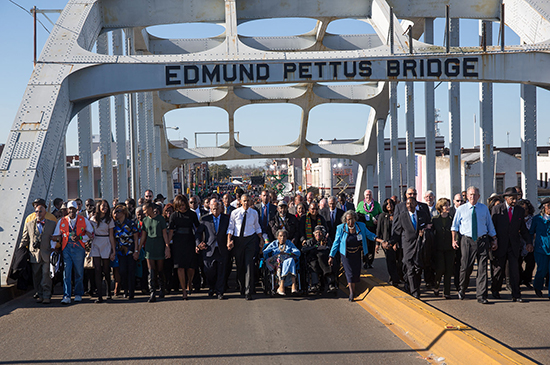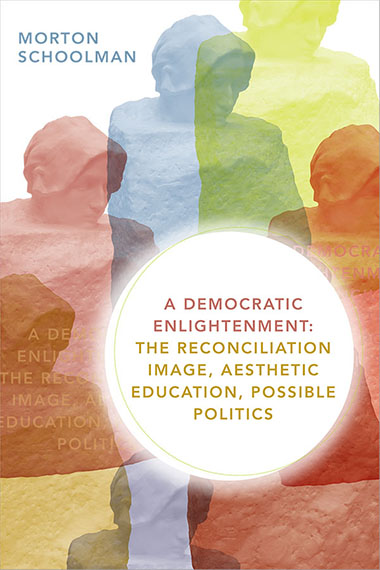A Democratic Enlightenment: Challenging our Notion of Reconciliation
 |
|
Marchers, including Congressman John Lewis, President Barack Obama and President George W. Bush cross the Edmund Pettus Bridge on the 50th anniversary of "Bloody Sunday." The 2015 event shows how the reconciliation image teaches the political lesson of identity becoming different in the image of difference, according to Professor of Political Science Morton Schoolman.
|
 |
|
A Democratic Enlightenment: The Reconciliation Image, Aesthetic Education, Possible Politics (Duke University Press, 2020)
|
ALBANY, N.Y. (August 18, 2020) – When U.S. Representative John Lewis died on July 17, it marked the passing of one of the most prominent voices of our nation’s civil rights movement of the 1950s and 1960s.
Images of Lewis in 1965, then the chairman of the Student Nonviolent Coordinating Committee, marching peacefully with 600 fellow civil rights activists on the Edmund Pettus Bridge in Selma, Alabama, were set against the horrifying images that immediately followed: Lewis and others brutally beaten by Sheriff Jim Clark and his officers without provocation. The incident, which became known as ‘Bloody Sunday,’ shocked the conscience of the nation. It also helped to bring about the passage of the Voting Rights Act of 1965.
But the life of Lewis can help serve another purpose today, as Rockefeller College Professor of Political Science Morton Schoolman sees it. Lewis’s journey epitomizes our nation’s struggle with reconciliation in the everyday ways we treat those different from ourselves. This concept of ‘reconciliation’ is at the heart of Schoolman’s new book, A Democratic Enlightenment: The Reconciliation Image, Aesthetic Education, Possible Politics (Duke University Press, 2020).
As he explains, largely inspired and instructed by the prose and poetry of Whitman’s and Adorno’s writings on politics and aesthetics, Schoolman’s concept of the reconciliation of identity and difference poses two challenges to our three best-known traditional understandings of reconciliation: the Christian notion of reconciliation addressed by Paul and Jesus in the oft-cited “New Testament Letters”; Hegel’s philosophical formulations; and its codification by the South African Truth and Reconciliation Commission. Schoolman’s challenges lie in his theorizing both the achievement of reconciliation and the possibility of a politics as the means to that end. But how is reconciliation to be achieved? And how is such a politics of reconciliation possible?
 |
|
Professor of Political Science Morton Schoolman
|
A visual image of reconciliation that had appeared in modern art, much like the Enlightenment playwright, poet, and philosopher Friedrich Schiller had predicted, Schoolman proposes, in our own times has begun to appear in film. And just as modern art does according to Schiller, Schoolman’s view is that film’s visual image of reconciliation models its achievement, explains its meaning, imagines its possibility. Film is a modern form of aesthetic education that teaches reconciliation and, as such a new form of democratic enlightenment, encourages a possible politics of the reconciliation of identity and difference.
Through moving images film teaches the public a modern democratic society’s highest ideal – valuing difference above all, overcoming our practices of discriminating against, marginalizing, and excluding those who appear different from the majority or the norm. In movies such as Tate Taylor’s 2011 work "The Help,: Elia Kazan’s 1947 best picture winner "Gentleman’s Agreement," and many other such cinematic examples he highlights, Schoolman sees the democratic pedagogy of the reconciliation image modeling the possible politics of eliminating the violence of constructing differences as the other. In each such film the reconciliation image comes to life in ways Schiller and Whitman and Adorno could only imagine.
Film’s reconciliation image is made up of a series of moving images – the identity, difference, all-inclusive, receptivity, and imitative image – the same moving images Schoolman argues Whitman and Adorno discover in modern artworks producing images of reconciliation, which now appear in films wherever its five images appear. We can begin to see how the reconciliation image teaches its lessons from an example of its “imitative image,” which Schoolman considers a powerful illustration of how film can encourage a possible politics of reconciliation.
In the politically polarized era of 2020, the visually striking image of the casket of John Lewis making a final journey across the Edmund Pettus Bridge is similarly an “imitative” moment belonging to the reconciliation ideal, said Schoolman. Changing the name of the Edmund Pettus Bridge would be a societal moment of reconciliation – as we evolve from honoring white supremacists in the early part of the 20th century to recognizing and celebrating those who helped bring about a more fair and just nation for all.
“As a white supremacist bridge becoming a black civil rights bridge, the John Lewis Bridge becomes a visual image of whites imitating blacks, of whites learning what it means to be Black in America and what it means for difference to be treated as the other, and to struggle for racial equality – the equality of differences,” said Schoolman. While not an example from his book, the bridge shows how the reconciliation image teaches the political lesson of identity becoming different in the image of difference. It provides a hopeful message when much of our society seems intent on converting differences to otherness.
It also symbolizes one of the critical reasons Schoolman embarked on writing A Democratic Enlightenment. Instead of demonizing difference as otherness, we are slowly moving toward a society “consisting of a togetherness of differences, where identity’s reconciliation with difference is both a consequence of and force for democratization,” said Schoolman.
Yet, as he stresses throughout his book, new differences are always in the process of coming into being in democratic societies, whether they originate from within or from without. So no matter the extent to which it has been achieved, the reconciliation of identity and difference is also and always an ideal to be continually striven for. Reconciliation, like democracy itself, Schoolman emphasizes, is always a time arrived and a time yet to come.
![]() For more news, subscribe to UAlbany's RSS headline feeds
For more news, subscribe to UAlbany's RSS headline feeds
A comprehensive public research university, the University at Albany-SUNY offers more than 120 undergraduate majors and minors and 125 master's, doctoral and graduate certificate programs. UAlbany is a leader among all New York State colleges and universities in such diverse fields as atmospheric and environmental sciences, business, education, public health,health sciences, criminal justice, emergency preparedness, engineering and applied sciences, informatics, public administration, social welfare and sociology, taught by an extensive roster of faculty experts. It also offers expanded academic and research opportunities for students through an affiliation with Albany Law School. With a curriculum enhanced by 600 study-abroad opportunities, UAlbany launches great careers.


